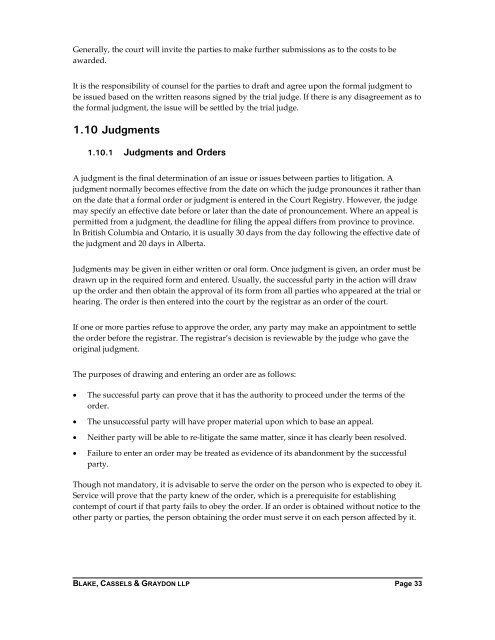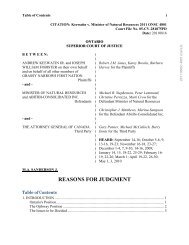Generally, the court will invite the parties to make further submissions as to the costs to beawarded.It is the responsibility of counsel for the parties to draft <strong>and</strong> agree upon the formal judgment tobe issued based on the written reasons signed by the trial judge. If there is any disagreement as tothe formal judgment, the issue will be settled by the trial judge.1.10 Judgments1.10.1 Judgments <strong>and</strong> OrdersA judgment is the final determination of an issue or issues between parties to litigation. Ajudgment normally becomes effective from the date on which the judge pronounces it rather thanon the date that a formal order or judgment is entered in the Court Registry. However, the judgemay specify an effective date before or later than the date of pronouncement. Where an appeal ispermitted from a judgment, the deadline for filing the appeal differs from province to province.In British Columbia <strong>and</strong> Ontario, it is usually 30 days from the day following the effective date ofthe judgment <strong>and</strong> 20 days in Alberta.Judgments may be given in either written or oral form. Once judgment is given, an order must bedrawn up in the required form <strong>and</strong> entered. Usually, the successful party in the action will drawup the order <strong>and</strong> then obtain the approval of its form from all parties who appeared at the trial orhearing. The order is then entered into the court by the registrar as an order of the court.If one or more parties refuse to approve the order, any party may make an appointment to settlethe order before the registrar. The registrar’s decision is reviewable by the judge who gave theoriginal judgment.The purposes of drawing <strong>and</strong> entering an order are as follows:• The successful party can prove that it has the authority to proceed under the terms of theorder.• The unsuccessful party will have proper material upon which to base an appeal.• Neither party will be able to re-litigate the same matter, since it has clearly been resolved.• Failure to enter an order may be treated as evidence of its ab<strong>and</strong>onment by the successfulparty.Though not m<strong>and</strong>atory, it is advisable to serve the order on the person who is expected to obey it.Service will prove that the party knew of the order, which is a prerequisite for establishingcontempt of court if that party fails to obey the order. If an order is obtained without notice to theother party or parties, the person obtaining the order must serve it on each person affected by it.BLAKE, CASSELS & GRAYDON LLP Page 33
1.10.2 Foreign Currency JudgmentsCommon Law. Under the common law, a money judgment had to be expressed in Canadi<strong>and</strong>ollars, <strong>and</strong> the date of conversion into Canadian dollars of sums agreed to be paid in a foreigncurrency was a matter of some controversy. The operative principle developed that the successfullitigant should be provided sufficient Canadian funds to purchase the amount awarded inforeign currency at the time of the judgment.Statutory Provisions. Legislation <strong>and</strong> procedural rules have clarified the law regarding foreigncurrency judgments in different provinces. The British Columbia Foreign Money Claims Act statesthat the court may order the unsuccessful party to pay that amount of Canadian currencyrequired to purchase the equivalent amount of foreign currency owing to the other party. Theforeign currency must be converted at a chartered bank located in British Columbia, <strong>and</strong> the dateof conversion is the last day that the bank quotes a Canadian dollar equivalent to the foreigncurrency prior to the day when the debtor makes a payment under the order. Under the OntarioCourts of Justice Act, similar provisions apply, but the bank must be listed under Schedule I of theCanadian Bank Act, <strong>and</strong> the judge has the discretion to fix a different date for conversion of thefunds. In Alberta, foreign currency judgments are still regulated by the common law. However,under the Alberta Rules of Court (for judgments from the United Kingdom) <strong>and</strong> the AlbertaReciprocal Enforcement of Judgments Act (for judgments from other reciprocating jurisdictions),when a foreign judgment (that is, a non-Alberta judgment) is subsequently registered in Alberta,it will be converted into Canadian currency at the exchange rate on either the date that the courtclerk registers the judgment for judgments from the United Kingdom, or the date of the originaljudgment for judgments from other reciprocating jurisdictions.1.10.3 InterestPre-Judgment Interest. The amount of interest payable on judgment debts may have been agreedupon by the parties in a contract. In such cases, pre-judgment interest will normally be based onthe contract. Note, however, that it is illegal in Canada to charge interest at an effective annualrate of over 60% <strong>and</strong> a rate stipulated on a monthly or daily basis may not be enforceable unlessthe contract expressly states the equivalent yearly rate of interest.In British Columbia, if there is no explicit or implied agreement between the parties, the rate willbe based on the Court Order Interest Act, which gives the judge discretion to fix an appropriaterate. Generally, such pre-judgment interest will be based on the rate set for 30-day commercialpaper. In Ontario, the rate is based on the Bank of Canada’s minimum rate for short-termadvances to Schedule I Canadian banks, <strong>and</strong> is calculated quarterly. In Alberta, the regulation tothe Judgment Interest Act fixes an annual rate for both pre- <strong>and</strong> post-judgment interest. Tables areregularly published by each provincial government showing the applicable rates of interestduring each period.Post-Judgment Interest. After judgment is pronounced, money awards in British Columbia willbear interest at a rate equal to the prime lending rate of the Bank of Canada. This rate is fixedeach half-year, on January 1 <strong>and</strong> July 1. However, the court does have the authority to fix adifferent interest rate. In Ontario, post-judgment interest is fixed every quarter, <strong>and</strong> is calculatedPage 34BLAKE, CASSELS & GRAYDON LLP
- Page 1 and 2: Litigation andDispute Resolutionin
- Page 4: 2.4 Burden of Proof ...............
- Page 7 and 8: criminal matters. The Superior Cour
- Page 9 and 10: II. ISSUES SPECIFIC TONON-CANADIAN
- Page 11 and 12: The money of account is the amount
- Page 13 and 14: Canadian courts give strong deferen
- Page 15 and 16: Parties, however, can agree at any
- Page 17 and 18: • The subject-matter of the dispu
- Page 19 and 20: Canada has negotiated an MLAT with
- Page 21 and 22: action to be commenced by way of a
- Page 23 and 24: exception of documents that are pri
- Page 25 and 26: documents with the court including
- Page 27 and 28: There are obvious limitations on th
- Page 29 and 30: • Compel a plaintiff to post coll
- Page 31 and 32: One mechanism used by Canadian cour
- Page 33 and 34: the timing and length of trial, and
- Page 35 and 36: 1.8.5 Costs in Class ProceedingsSee
- Page 37: Canadian jurisprudence is not unani
- Page 41 and 42: 1.11.2 Standard of ReviewOn appeals
- Page 43 and 44: can be sold, and others have waitin
- Page 45 and 46: Quebec, the application or motion t
- Page 47 and 48: adjudicated the common issues, then
- Page 49 and 50: and with whether the decision falls
- Page 51 and 52: authority to conduct administrative
- Page 53 and 54: government permit, often generates
- Page 55 and 56: the CITT are given considerable wei
- Page 57 and 58: mediate and resolve disputes after
- Page 59 and 60: There are also circumstances in whi
- Page 61 and 62: VI. DOMESTIC ARBITRATIONThere is an
- Page 63 and 64: specify the rules of procedure that
- Page 65 and 66: VII. TYPICAL CIVIL CLAIMSWhile ther
- Page 67 and 68: 1.8 Other RestrictionsStatutory lim
- Page 69 and 70: In circumstances where there may be
- Page 71 and 72: • Destruction or delivery up of t
- Page 73 and 74: 4.6 DamagesIn defamation cases, dam
- Page 75 and 76: VIII.QUEBEC LAW AND PROCEDURE1. Ove
- Page 77 and 78: Where the debtor fails to perform h
- Page 79 and 80: To blunt the impact of the generali
- Page 81 and 82: (that is, a complete indemnity), in
- Page 83 and 84: OFFICE LOCATIONSMONTRÉAL600 de Mai
















